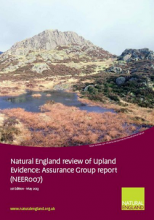The Uplands Evidence Review, which was published on 30th May 2013, was undertaken to ensure that Natural England uses the most robust evidence available when formulating advice and taking decisions related to its work in the uplands. The review programme concentrates on the evidence relating to biodiversity and ecosystem services in the uplands and the impact of land management activities upon them.
The review considered five priority topics in depth. Each topic focused on a series of questions which were evaluated against the available scientific evidence. The topics were identified following stakeholder input and reflection on areas where evidence and advice was subject to greatest challenge. The five topics were:
- The impact of tracks on the integrity and hydrological function of blanket bog.
- Restoration of degraded blanket bog.
- The effects of managed burning on upland peatland biodiversity, carbon and water.
- Upland hay meadows: what management regimes maintain the diversity of meadow flora and populations of breeding birds.
- Moorland grazing & stocking rates.
The review has now been completed and, following an external assurance process and scrutiny by Natural England’s Science Advisory Committee the review will be a vital source of evidence in determining the future direction of Natural England’s delivery in the uplands of England.
A detailed report on each of the five topics covered by the review programme is available along with information on the methodology and the assurance process. The Assurance Report contains five shorter topic summaries of the findings.
The review programme will help strengthen the management advice Natural England provides to its customers, in particular around some of the topic areas which were discussed in depth, for example:
- How tracks effect the structure of blanket peat and its hydrological system.
- Is a full recovery to a functioning blanket bog possible?
- What happens after the burning of blanket bog and wet heath? How might the habitat species be affected?
- What type and quantity of fertiliser can be applied to our upland hay meadows without a negative impact on species diversity?
- The moorland grazing & stocking rate topic has been documented, it is however notable, that very little (approximately 20%) of the evidence can be considered as ‘strong’ - does one size fit all?
The above represent some of the discussion subjects; the full topic reviews contain more detail.
Other information - such as social and economic factors, current working practices and geographic scale - did not form part of the first stage of the evidence review project. These factors, together with further consideration on the conclusions from the review programme, will be included in the next stage.
Available at: http://publications.naturalengland.org.uk/category/5968803
